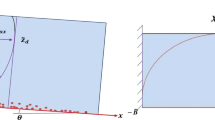Abstract
Flows carrying bottom materials have a wide range of possible applications, especially in the technological and natural fields (Benaissa, Eléments de mécanique des sols. OPU, 1993). These flows that are loaded with granular materials are transport phenomena with diverse and complex mechanisms. They are characterized by the suspension of particles by turbulence, vertical density and velocity profiles, and deposition/erosion processes on the bottom of natural channels as the flow passes. The objective of this research is to experiment with the effects of the rough bottom (Recking, Etude expérimentale de l'influence du tri granulométrique sur le transport solide par charriage, 2006) on the dynamic behaviour of flows carrying solid particles of varying size, to study the behaviour of solid transport under the influence of certain easily accessible parameters, and, finally, to describe, as far as possible, the interactions between the solid particles and the water flow. These flows, responsible for sediment transits, are generally described by: Reynolds number (turbulence intensity), Stokes number (particle inertia), Rouse number, and Froude number (gravity effects). The equations governing the dynamics of particles in turbulence are complex (Gatignol, Journal De Mécanique Théorique Et Appliquée 2:42, 1983; Maxey and Riley, Phys Fluids 26:883, 1983). Most models rely on many simplifications and empirical corrections when the particle Reynolds \({\mathrm{R}}_{\mathrm{ep}}=\frac{\left({U}_{f}-{U}_{p}\right)d}{\nu }\) is very high. Experimental studies are therefore always necessary to get around this pitfall. This study is part of a project which consists in evaluating the effects of a rough bottom on the dynamic behaviour of flows carrying solid particles of variable size on a reduced model of a tiltable channel at the Hydraulics Laboratory of the University of Batna 2. The particles are entrained by a fast, turbulent, and supercritical liquid flow. It also consists in numerically simulating the flow of a mixture of fluid and solid particles in a rectangular channel to understand the interactions between the particles and the carrier phase. The study on the laws of friction in river beds aims at evaluating the impact of flows on the materials constituting the bottom of natural channels. The results obtained by simulation using the CLIPPER.5 program and PCA (Principal Component Analysis) are compared with the experimental results from the University of Batna 2. A good agreement is observed between the experimental values and those calculated during the simulation for high Re numbers.











Similar content being viewed by others
References
Barnes HH (1967) Roughness Characteristics of Natural Channels. U.S.Geological survey-supply paper 1849.United States Government printing office, Washington, DC
Benaissa A (1993) Eléments de mécanique des sols. OPU
Bergeron N, Charbonneau P (1999) The effect of sediment concentration on bed load roughness. Hydrol Process 13:2583–2589
Bray DI (1979) Estimating average velocity in gravel beds rivers. Journal of Hydraulic Division. https://doi.org/10.1061/JYCEAJ.0005270
Chassaing P (1997) Mécanique des fluides éléments d'un premier parcours
Chin, Wohl (2005) Church et Zimmerman, 2007
Clancy K (2021) Characterizing clustering in boulder bed channels and the impact on shear stress equations. J Water Resour Prot. https://doi.org/10.4236/jwarp.2021.134017
Gatignol R (1983) The Faxen formulae for a rigid particle in an unsteady non-uniform Stokes flow. Journal De Mécanique Théorique Et Appliquée 2:42
Giles RV (1982) Mécanique des fluides et hydraulique–cours et problèmes. Edition française Michel Lobenberg
Graf WH, Altinakar MS (1996) Hydraulique fluviale. Tome 2, Écoulement non permanent et phénomènes de transport. Presses polytechniques et universitaires romandes, Lausanne
Jamme G (1974) Travaux fluviaux
Jinjin W (1991) Résistance of flow over rough bed. J Hydrodyn. China ocean press
Khanfouf O, Fouraret FZ et al (2022) Infuence of model selection on the temperature feld and turbulent energy dissipation rate in a hydraulic system with a complex geometry. Modeling Earth Systems and Environment. https://doi.org/10.1007/s40808-022-01591-4
Labiod C (2005) Ecoulement à surface libre sur fond de rugosité inhomogène. Institut de Mécanique des Fluides, Toulouse
Lebreton JC (1974) Dynamique fluviale. Editions Eyrolles
Masson E, Comolet R (1992) Mécanique expérimentale des fluides. Tome III, Recueil d'exercices
Maxey MR, Riley JJ (1983) Equation of motion for a small rigid sphere in a nonuniform flow. Phys Fluids 26(4):883
Ouziaux R (2004) Mécanique des fluides appliquée. Paris: Ed. Dunod
Rachid C (2022) Modélisation mathématique et simulation numérique des écoulements turbulents anisotropes et instationnaires dans une conduite à géométrie circulaire. Université de Batna2
Recking A (2006) Etude expérimentale de l'influence du tri granulométrique sur le transport solide par charriage
Recking A, Frey P, Paquier A, Belleudy P, Champagne JY (2008) Feedback between bed load and flow resistance in gravel and cobble bed rivers. Water Resour Res 44:21
Schiestel R (1998) Les écoulements turbulents modélisation et simulation. Editions Hermes
Taylor and Francis (2007) A new approach to sediment transport in the design and operation of irrigation canals
Te Ven C (1959) Open-Channel Hydraulics. Mc Graw-Hill, Toronto
Viollet P, Esposito JPCP, Laurence D (1998) Mécanique des fluides appliquées. Presses de l'école nationale des ponts et des chaussées
Author information
Authors and Affiliations
Corresponding author
Additional information
Publisher's Note
Springer Nature remains neutral with regard to jurisdictional claims in published maps and institutional affiliations.
Rights and permissions
Springer Nature or its licensor (e.g. a society or other partner) holds exclusive rights to this article under a publishing agreement with the author(s) or other rightsholder(s); author self-archiving of the accepted manuscript version of this article is solely governed by the terms of such publishing agreement and applicable law.
About this article
Cite this article
Fourar, F.Z., Fourar, A., Khanfouf, O. et al. Experimental study and numerical simulation of fluvial dynamics and sediment transport in instationary flow conditions. Model. Earth Syst. Environ. 9, 4155–4167 (2023). https://doi.org/10.1007/s40808-023-01722-5
Received:
Accepted:
Published:
Issue Date:
DOI: https://doi.org/10.1007/s40808-023-01722-5




